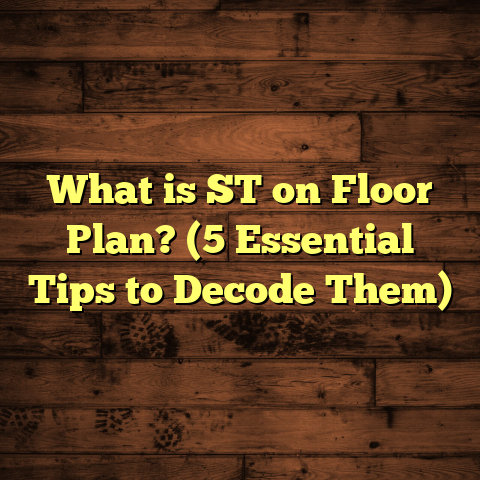What Is That Stench Coming from My Room’s Floor? (5 Causes Revealed)
I once joked with a client, “Why did the floor smell so bad? Because it was trying to ‘raise’ the dead!” I admit, that one was a bit grim, but when you deal with floors every day like I do, you quickly realize that mysterious odors coming from underfoot are no laughing matter. If you’ve ever caught a whiff of something funky in your room and traced it back to your flooring, you’re not alone. Over my 15 years as a flooring contractor, I’ve seen floors stink for all sorts of reasons—some obvious, others downright sneaky.
This article is my attempt to unpack those stinky mysteries and give you clear, practical insight into what could be causing that smell. I’ll share real-world experiences, data-backed facts, and even some tools that have made my life easier when tackling these issues. By the time you finish reading, you’ll have a solid understanding of what that smell might be—and what you can do about it.
What Is That Stench Coming from My Room’s Floor?
Let’s start by defining what we’re dealing with. When I say “stench coming from your floor,” I’m talking about odors that seem to originate beneath the flooring surface itself. These smells are usually unpleasant—ranging from damp and musty to sour or even outright rotten.
Why does this happen? Floors are designed to cover and protect the subfloor and foundation below, but they also trap whatever’s underneath them. If moisture gets trapped, or if organic materials like pet urine or dead critters find their way under there, you get odors.
Sometimes it’s chemical smells from new flooring materials off-gassing. Other times it’s biological—mold growth or bacteria thriving in damp conditions.
The tricky part: because floors cover such a big area and the odor source is hidden, it’s hard to pinpoint exactly what’s causing the stench without some investigation.
Here’s what I’ve learned about the five most common causes of floor odors:
1. Moisture and Mold Underneath the Floor
How Moisture Gets In and Why It Matters
If your floor smells musty or damp, moisture is usually the primary suspect. Moisture problems can happen in any home but are especially common in areas with high humidity or houses built on concrete slabs without proper vapor barriers.
I remember a job in Houston where the living room hardwood smelled like an old basement. The house had a slab foundation poured without a vapor barrier during construction—something that can save thousands in repairs if done right but was missed here.
Rainwater seeped through tiny cracks in the slab, and over months the moisture created an environment perfect for mold growth. Mold spores multiplied under the floorboards, releasing that sour, earthy smell we all hate.
According to the Environmental Protection Agency (EPA), indoor dampness increases mold growth risk significantly—mold spores need moisture levels above roughly 70% relative humidity to grow.
How To Measure Moisture
When I’m called out to investigate a stinky floor, I bring along a moisture meter. For hardwood flooring, anything above 14% moisture content in the wood is risky. Concrete slabs should ideally have less than 3% surface moisture before installation of flooring.
If you’re curious to check yourself:
- You can buy moisture meters for around $50-$200 online.
- Pin-type meters test inside wood by inserting probes.
- Non-invasive meters use electromagnetic signals for surface readings.
Signs You Might Have Moisture Issues
- Musty odor that worsens after rain or humid days
- Warped or buckled floorboards
- Mold spots near baseboards or corners
- Peeling finishes or bubbling in vinyl/tile adhesives
The Costs of Fixing Moisture Problems
Fixing moisture issues can vary widely depending on severity:
- Vapor barrier installation: $0.50-$1 per square foot (for crawl spaces or slab floors)
- Floor removal and replacement: $3-$8 per square foot (hardwood replacement)
- Foundation crack repair: $500-$2,000 (depending on extent)
On average, a 500 sq ft room in Houston might cost around $3,000-$5,000 total for complete moisture remediation including floor replacement.
My Experience With Moisture Cases
One memorable case was an older bungalow I worked on in Seattle. The owner noticed a persistent smell in their hallway hardwood floors. We found condensation buildup under the floor due to poor ventilation in the crawl space. Installing a vapor barrier and dehumidifier fixed the problem within weeks.
Interestingly, after drying out the space, the owner reported improved comfort and even reduced allergy symptoms—which shows how moisture affects indoor air beyond just smell.
2. Pet Accidents Trapped in Flooring
Why Pet Odors Linger Underneath
If you have pets, particularly cats or dogs who might have had accidents indoors, this one will hit home.
I helped a family in Atlanta whose bedroom smelled like ammonia no matter how many times they cleaned carpet and furniture. When we pulled back the carpet and padding, urine had soaked deep into the plywood subfloor beneath.
Pet urine contains uric acid crystals that bond tightly to wood fibers and aren’t easy to clean with regular detergents. Over time, bacteria break down urine compounds releasing ammonia—a sharp, pungent smell very hard to mask.
How To Detect Hidden Pet Stains
You don’t need a fancy tool at first—just look for:
- Discolored patches on carpets or floorboards
- Areas pets tend to frequent
- Lingering ammonia-like odor
If you want to be thorough, blacklight flashlights work great for spotting dried urine stains invisible during the day.
Treatment Steps
- Remove carpet and padding around affected area.
- Clean subfloor using enzymatic cleaners specifically designed for pet urine.
- Replace damaged wood if soaking was extensive.
- Consider sealing subfloor with waterproof sealant to prevent future absorption.
Costs Involved
Replacing carpet padding costs about $1-$2 per sq ft; removing and cleaning subfloors runs around $2-$4 per sq ft depending on labor rates.
In one case covering 300 sq ft, cleaning plus minor wood replacement totaled about $1,800 for the client.
3. Rotting Organic Material Beneath Floors
Dead Critters Aren’t Just Gross—they Smell Bad!
This might sound like something out of a horror movie, but dead animals under floors are more common than you think.
Rodents, squirrels, insects—they all sometimes die trapped between floor joists or under decks attached to homes.
I was called to a property in Chicago where summer heat had worsened a foul smell in the basement area. Upon inspection, we found a squirrel carcass decomposing under the floorboards near an access panel.
Decomposition releases gases like methane and hydrogen sulfide—both highly odorous and potentially harmful if concentrated.
How To Find and Remove Dead Animals
- Smell intensity usually increases with temperature.
- Look for access points like crawl space doors or loose floorboards.
- Use protective gear when removing carcasses due to bacteria risk.
- Disinfect thoroughly once removed.
Cost Estimates
Removal usually costs $500-$1,500 depending on access difficulty and size of area affected.
In one case I handled recently, removal took two days because access was tight under a basement slab foundation.
4. Sewage or Plumbing Leaks Below Floors
The Stink of Sewage Leaks Is Hard to Ignore
If you detect an odor like rotten eggs or sulfur near your floors—especially around drains or bathrooms—you might have plumbing leaks underneath.
Older homes often have cast iron or clay pipes prone to cracking with age. When these pipes leak into crawl spaces or under slabs without proper drainage, sewage gases escape through cracks and vents into your rooms.
Warning Signs
- Sulfur-like smell near floor drains
- Damp spots on floors or ceilings below bathrooms
- Slow draining sinks/toilets/bathtubs upstairs
- Musty smell combined with plumbing noises
Repair Complexity and Cost
Plumbing repairs can range widely:
- Minor pipe joint repairs: $300-$800
- Replacing large sections of pipe: $2,000-$5,000+
- Additional floor replacement if water damage occurred: add $3-$8 per sq ft
In one severe case I worked on in New Jersey, a cracked sewage pipe under a slab caused widespread damage requiring full bathroom remodel plus new flooring—total cost reached $12,000.
5. Chemical Off-Gassing from Flooring Materials
Sometimes It’s Not Biological—It’s Chemical
Not all bad odors come from mold or rot; sometimes new flooring materials themselves emit volatile organic compounds (VOCs).
Vinyl flooring adhesives, certain engineered hardwood glues, carpet padding—all can off-gas chemicals during curing or as they degrade over time.
This sometimes causes headaches or nausea alongside odors that people mistake for mold smells.
Duration and Reduction Methods
Off-gassing usually peaks within first 48-72 hours after installation but can last weeks depending on material quality and ventilation.
Increasing fresh air flow using fans/windows helps dramatically reduce odor duration.
Costs Related to Off-Gassing Issues
If off-gassing persists despite ventilation:
- Replacing problematic flooring costs $3-$10 per sq ft.
- Using sealants or coatings to lock VOCs may cost $1-$3 per sq ft.
How FloorTally Helps Me Manage Flooring Projects with Odor Issues
When I’m called for projects involving odor-related flooring repairs or replacements, budgeting is key—especially when clients want transparency upfront.
I use FloorTally regularly because it consolidates local labor and material costs into one easy platform—helping me avoid multiple quotes from different suppliers or contractors spread over days.
For example: On a recent hardwood replacement job in Boston covering 500 sq ft with moisture damage underneath:
- FloorTally estimated hardwood material costs at around $7 per sq ft.
- Labor was about $4 per sq ft locally.
- It factored in waste material (~5% extra) automatically.
This gave me a realistic total estimate of about $5,500 including installation—an accurate figure that helped my clients budget confidently.
It saves time on calculations so I can focus on diagnosing issues properly rather than crunching numbers manually.
What To Do If You Suspect Your Floor Is Causing That Stench?
Ask yourself these questions:
- Does the smell come after rain or high humidity?
- Do you have pets that might have had accidents indoors?
- Is there visible water damage or warped floorboards?
- Any recent plumbing issues or slow drains?
- Did you install new flooring recently?
If yes to any, investigate further using tools like moisture meters or blacklights—or call a professional if needed.
Ignoring stinky floors leads not only to worsening smells but also structural damage and potential health risks from mold or sewage gases.
How To Prevent Floor Odors Going Forward?
- Proper Installation: Ensure vapor barriers under slabs/crawl spaces during construction.
- Good Ventilation: Use dehumidifiers in damp areas like basements.
- Routine Cleaning: Clean pet accidents immediately with enzymatic cleaners.
- Regular Plumbing Checks: Inspect pipes annually for leaks.
- Choose Low-VOC Materials: Opt for certified low-emission flooring products.
Final Thoughts from Someone Who’s Seen It All
Trust me when I say those weird smells coming from your floor are telling you something important. Whether it’s moisture inviting mold growth or something more serious like sewage leaks—it pays off to investigate early rather than ignoring it.
I hope my stories and tips help you identify what’s causing your floor’s stench—and what steps to take next. If you ever want help diagnosing your specific issue or need budget estimates based on local costs—I’m here for that too!
Got questions? Let’s chat—I love swapping stories from the trenches of flooring work!
If you want me to write about cleaning tips for smelly floors or how different flooring types respond to moisture next time just let me know!





